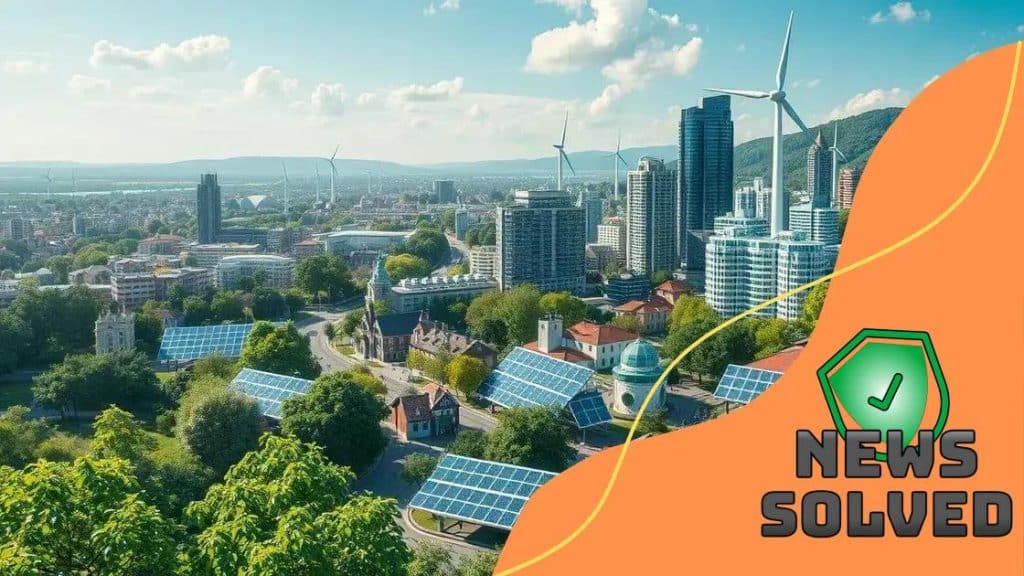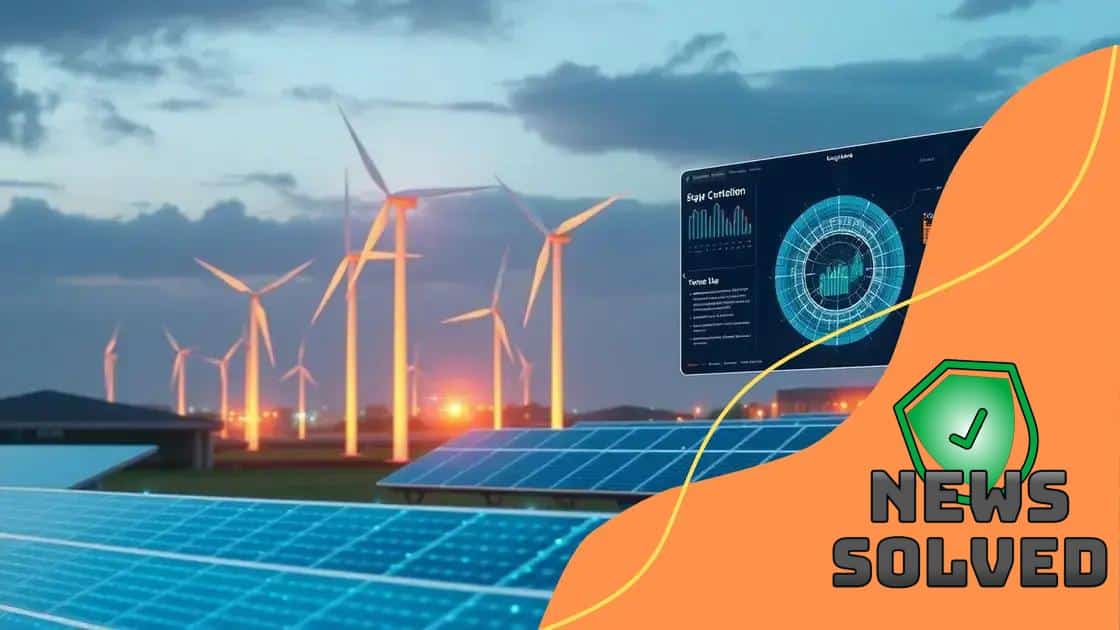The role of AI in reducing carbon footprints across industries

Advertisements
The role of AI in reducing carbon footprints across industries involves optimizing energy use, improving waste management, and enabling real-time monitoring, significantly enhancing sustainability efforts.
The role of AI in reducing carbon footprints across industries is becoming more significant as we face climate change challenges. Have you wondered how technology can help us live more sustainably? This article explores the impactful ways AI can contribute to a greener future.
Advertisements
Understanding carbon footprints and their impact
Understanding carbon footprints is crucial in addressing climate change. These footprints measure the total greenhouse gases emitted, directly and indirectly, by individuals, organizations, or products. By grasping this concept, we can more effectively strategize ways to diminish environmental impact.
What is a Carbon Footprint?
A carbon footprint refers to the total amount of carbon dioxide emissions produced by human activities. It encompasses everything from driving a car to manufacturing products. Analyzing these footprints helps identify significant sources of emissions.
Importance of Reducing Carbon Footprints
Reducing our carbon footprint is vital for maintaining the planet’s health. Here are some key reasons:
Advertisements
- Lowering greenhouse gas emissions mitigates climate change.
- Improving air quality enhances public health.
- Promoting sustainability helps preserve ecosystems.
By employing strategies that reduce our carbon footprints, industries can create a more sustainable future. From renewable energy sources to energy-efficient technologies, there are numerous methods to tackle the issue.
Furthermore, educating others about carbon footprints is transformative. When communities understand their emissions, they can actively participate in reducing them. This awareness leads to collective efforts toward a cleaner environment. Implementing simple changes in daily routines can have a profound impact.
As we delve deeper into understanding carbon footprints, it’s essential to recognize their widespread effects. Industries must adopt innovative practices to minimize their environmental impact. The transition to greener solutions involves collaboration across sectors, promoting a culture of sustainability.
How AI analyzes environmental data
How does AI analyze environmental data? This technology leverages algorithms and machine learning to process vast amounts of information quickly. By doing so, AI provides insights that can lead to significant improvements in sustainability efforts.
Data Collection
AI begins its work by gathering data from various sources. Sensors, satellites, and public databases offer a wealth of information. The collection process ensures that the AI has access to real-time data, essential for making informed decisions.
Data Processing
After collecting data, AI uses complex algorithms to filter and analyze it. Here are key steps involved in this process:
- Assessing data quality to ensure accuracy.
- Identifying patterns and trends over time.
- Predicting future environmental impacts based on past data.
This data processing allows for a better understanding of environmental changes, helping organizations take appropriate measures.
Furthermore, AI can create visual representations of data, such as charts and graphs. These visuals help stakeholders grasp complex information easily. By transforming raw data into understandable formats, AI enhances communication among teams and the public.
As AI continues to evolve, its ability to analyze environmental data will only improve. This advancement opens doors to innovative solutions for reducing carbon footprints. By harnessing AI’s capabilities, industries can become more efficient and environmentally friendly.
Case studies of AI in energy sectors

Case studies of AI in energy sectors illustrate how technology is transforming the way we produce and consume energy. By applying artificial intelligence, companies can optimize operations, reduce costs, and contribute to a lower carbon footprint.
Optimizing Energy Production
In various energy sectors, AI is utilized to enhance production efficiency. For instance, wind farms are using AI to analyze weather patterns. This data helps predict energy output by adjusting blade angles and turbine speeds accordingly. The result is a more consistent and efficient energy supply.
Enhancing Grid Management
AI is also crucial in improving grid management. Here are a few ways it achieves this:
- Predictive maintenance reduces downtime by identifying potential equipment failures before they happen.
- Load forecasting helps in balancing supply and demand more effectively.
- Smart grids utilize AI to manage energy distribution, increasing reliability.
Many utilities are adopting these technologies to create a more resilient energy infrastructure. With AI, they can forecast energy demands and adjust supply in real-time, leading to fewer blackouts and more efficient energy use.
Moreover, AI aids the integration of renewable energy sources. By analyzing fluctuating inputs from solar and wind, AI systems help maintain grid stability. This advancement is essential as the world moves towards cleaner energy solutions.
Companies like Google have demonstrated significant reductions in energy costs and emissions by harnessing AI. Their data centers leverage machine learning to optimize cooling systems, showcasing the wide-reaching benefits AI offers across the energy sector.
Implementing AI solutions for better sustainability
Implementing AI solutions for better sustainability is a vital step in modern industry practices. As businesses face growing pressure to minimize their environmental impact, AI offers innovative ways to enhance sustainability.
Streamlining Operations
AI helps companies streamline operations by optimizing resource use. This includes reducing energy consumption in production processes. For example, AI systems can analyze energy data in real-time, allowing companies to adjust their operations based on demand. This responsiveness reduces waste and lowers costs.
Waste Management
Another area where AI shines is in waste management. Companies are using AI-driven technologies to:
- Sort recyclables more effectively, increasing recycling rates.
- Monitor waste levels in real-time, optimizing collection routes.
- Predict waste generation patterns to enhance planning.
These improvements contribute to lower landfill usage and a more circular economy. With AI, businesses can transform waste into valuable resources, fostering a sustainable approach.
Moreover, AI facilitates the development of sustainable products. By analyzing customer preferences and environmental impact data, companies can design products that meet eco-friendly standards. This ensures that sustainability becomes a core aspect of product development rather than an afterthought.
As companies adopt AI solutions, they also enhance their ability to report on sustainability metrics. Data analytics allows for better tracking of sustainability goals and compliance with regulations. Transparent reporting fosters trust among consumers and stakeholders alike.
Future trends in AI and environmental responsibility
Future trends in AI and environmental responsibility reflect a growing commitment to sustainability across industries. As technology evolves, AI will play an even more crucial role in helping organizations minimize their environmental impact.
Increased Integration of AI
Companies will increasingly integrate AI into their sustainability practices. This integration will lead to smarter resource management. For example, AI can optimize energy use in buildings by learning patterns and adjusting systems accordingly.
Advancements in Renewable Energy
AI will also drive advancements in renewable energy technology. Here are some trends to watch:
- Improved energy storage solutions through predictive analytics.
- Enhanced grid management using AI algorithms to balance supply and demand.
- Increased efficiency in solar panel and wind turbine output using data insights.
As these technologies develop, they will significantly lower costs and increase the adoption of renewable energy sources.
Moreover, businesses will use AI to analyze their supply chains for sustainability. By monitoring every step in the supply process, companies can identify areas where they can reduce waste and emissions. This comprehensive approach fosters a circular economy, where resources are reused and recycled.
Another exciting trend is the rise of AI in environmental monitoring. Improved sensors and data collection methods will enhance AI’s ability to track environmental changes in real-time. This real-time data helps organizations respond quickly to issues such as pollution and deforestation.
FAQ – Frequently Asked Questions about AI and Environmental Responsibility
How does AI help reduce carbon footprints?
AI optimizes processes, improves energy efficiency, and enhances waste management, making it easier for companies to lower their carbon emissions.
What are some examples of AI in renewable energy?
AI is used to predict energy production from solar and wind sources and to optimize energy storage solutions, helping to ensure a reliable energy supply.
How can businesses utilize AI for sustainability reporting?
Businesses can use AI to analyze data on their environmental impact, track sustainability metrics, and generate reports that highlight their progress.
What future trends should we expect in AI and sustainability?
We can expect increased integration of AI in all sectors, real-time environmental monitoring, and advancements in energy-efficient technologies that contribute to a sustainable future.





